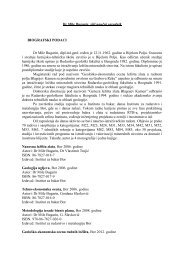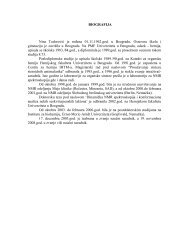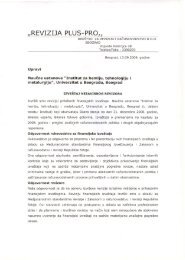Радно искуство - IHTM - Универзитет у Београду
Радно искуство - IHTM - Универзитет у Београду
Радно искуство - IHTM - Универзитет у Београду
You also want an ePaper? Increase the reach of your titles
YUMPU automatically turns print PDFs into web optimized ePapers that Google loves.
D. MARINKOVIĆ et al.: MOTOR FUEL CONSUMPTION IN SERBIA Hem. ind. 66 (3) 413–423 (2012)<br />
The motor fuels taken into consideration were gasoline,<br />
diesel and liquefied petroleum gas (LPG). Corrections<br />
were done using five parameters (P1 to P5):<br />
Duk,j = (a + b×GDP PPPPC,j)ΣPi,j<br />
(1)<br />
where Duk,j represents the total consumption of motor<br />
fuels in the year j; a and b are the intercept and slope<br />
of fitted linear dependence, respectively; Pi,j are correction<br />
factors; i is the number of correction factor, 1–5; j<br />
is the year, 2001–2025.<br />
The historic volume of motor fuel consumption in<br />
Serbia was obtained from the Statistical Office of Serbia,<br />
the Serbian state energy balances and analytical<br />
documentation of the Refinery “NIS”, while GDP PPPPC<br />
based on the use of data of the Statistical Office of<br />
Serbia and the International Monetary Fund (IMF).<br />
Correction factors Pi are the relevant parameters<br />
that affect on the consumption of motor fuels, derived<br />
from the analysis above mentioned influencing factors:<br />
1) P1 is the factor of specific fuel consumption;<br />
2) P2 is the average mileage factor;<br />
3) P3 is factor changes in crude oil price;<br />
4) P4 is the alternative fuels impact factor;<br />
5) P5 is the impact factor of vehicles air conditioning.<br />
It should be noted that for any of the analyzed influential<br />
factors there are almost no relevant data regarding<br />
the Republic of Serbia. This has prompted several<br />
different concepts to be applied, separately or in<br />
combination: carrying out of analogies, comparative<br />
analysis, and the analysis of statistical data of other<br />
countries. Each parameter had an independent analysis<br />
according to their different nature, and therefore some<br />
are simple and others are more complex.<br />
Parameter identification<br />
Gross domestic product per capita calculated at<br />
purchasing power parity (GDP PPPPC)<br />
As noted above, the GDP calculated by purchasing<br />
power parity by 2010 was taken from the Statistical<br />
Office of Serbia. For the period until 2016,the GDP<br />
were taken as forecasts of the IMF [13]. For the period<br />
after 2016, there are no projections of relevant international<br />
organizations dealing with macro-economic<br />
forecasts. Based on analogies with neighbouring countries<br />
that have made the transition and the latest projections<br />
presented in the recently launched strategy paper<br />
“Post-Crisis model of economic growth and development<br />
of Serbia 2001–2020”, was adopted that from<br />
the 2017 to 2025 the GDP PPPPC in Serbia will grow at<br />
an average rate of 5.5% [13–14].<br />
P1 – The factor of specific fuel consumption<br />
The pace of improvement of energy efficiency of<br />
motor vehicles by the end of the twentieth century was<br />
quite slow. The automobile market is dominated by the<br />
sales trend of bigger, stronger and more comfortable<br />
vehicles (such as, more often the presence of vehicles<br />
air conditioners, etc.) that use more energy per distance<br />
travelled, thus reducing the effects of savings on<br />
the basis of continuous technological and technical<br />
progress in the field of production of energy efficient<br />
engine.<br />
From 2000 to 2005, significant progress was done in<br />
terms of increasing the energy efficiency of the vehicle<br />
engine. Specific consumption of motor fuel, measured<br />
in L per 100 km, has decreased from 2000 to 2005 from<br />
about 11.0 to 10.3 [15–17].This corresponds to average<br />
increase energy efficiency by about 1.4% per year. Increased<br />
efficiency is the result of combining the effects<br />
of increasing fuel prices, motivation for restrained<br />
behaviour in driving and designing more fuel-efficient<br />
engines.<br />
The increasing number of vehicles with higher coefficients<br />
of specific energy consumption in recent years,<br />
such as SUV (sport utility vehicle), failed to threaten the<br />
downward trend in specific energy consumption in<br />
transportation sector (Figure 2). In support of continued<br />
downward trend and environmental directives<br />
of the EU from 2009 in the specific CO2 emissions for<br />
new vehicles[18], projections of different institutions<br />
show further reduction in specific energy consumption<br />
at a rate of about 1.25% per year, which by 2030 could<br />
lead to an average consumption of motor fuels from<br />
7.5 L/100 km [15]. In the analysis of specific fuel consumption<br />
in Serbia, the actual trend for the European<br />
Union (EU) was adopted, where statistics of the candidate<br />
countries for EU membership were taken in the<br />
analysis.<br />
P2 – The average mileage factor<br />
In the last two decades, there has been a trend<br />
throughout Europe that the average mileage per vehicle<br />
per year decline at an average rate of 0.1% per<br />
year (Figure 3). Predictions are that this trend will hold<br />
in the future [17]. This trend is adopted in this analysis<br />
for Serbia.<br />
P3 – Factor changes in crude oil prices (Figure 4)<br />
Numerous studies around the world contain a prediction<br />
of price movements of crude oil in the future.<br />
One of most relevant organization that deals with this<br />
issue is the U.S. Energy Information Administration<br />
(U.S. EIA). In its annual energy outlook for 2010, it<br />
provides a forecast of crude oil prices until 2035, in several<br />
different scenarios. In this analysis, the so-called<br />
“'middle” scenario has been adopted [19–20].<br />
In the study “European Energy and Transport:<br />
Trends to 2030 – Update 2007” it was concluded that<br />
with doubling the price of crude oil, motor fuel price<br />
increases on average by 35%, which then leads to a<br />
415







